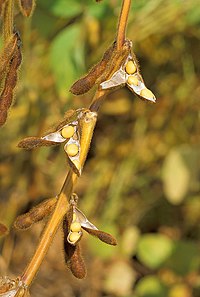
Photo from wikipedia
BACKGROUND Chickpea is a rich source of proteins with well-balanced amino acids, dietary fibers, vitamins, minerals, and phytochemicals. In this study; immature, mature, germinated, fermented, and black chickpea flours at… Click to show full abstract
BACKGROUND Chickpea is a rich source of proteins with well-balanced amino acids, dietary fibers, vitamins, minerals, and phytochemicals. In this study; immature, mature, germinated, fermented, and black chickpea flours at a 20% ratio were used in breadmaking to reduce glycemic index and enhance nutritive value. The effects of chickpea flours on the physical, chemical, and textural characteristics, antioxidant properties and in vitro glycemic index of bread were compared. RESULTS Compared to the control (100% wheat bread), the inclusion of chickpea flours at a 20% ratio generally showed greater ash, fat, and protein contents in bread. The use of immature, germinated and fermented chickpea flours in bread elicited lower phytic acid concentration than that of bread containing mature and black chickpea flours. On the other hand, the inclusion of immature and germinated chickpea flours presented the highest total phenolic content in bread. Moreover, in vitro glycemic index values of loaves made with chickpea flours were markedly lower (at least 11%) than the control. The specific volume values of bread samples formulated with chickpea flours (except for fermented chickpea flour) were similar (P > 0.05) to each other. Bread samples containing immature and germinated chickpea flours exhibited lower hardness and chewiness than those of other samples containing chickpea flours. CONCLUSION The findings showed that immature, germinated and black chickpea flours are a good alternative to mature chickpea flour to produce healthy bread. This article is protected by copyright. All rights reserved.
Journal Title: Journal of the science of food and agriculture
Year Published: 2022
Link to full text (if available)
Share on Social Media: Sign Up to like & get
recommendations!